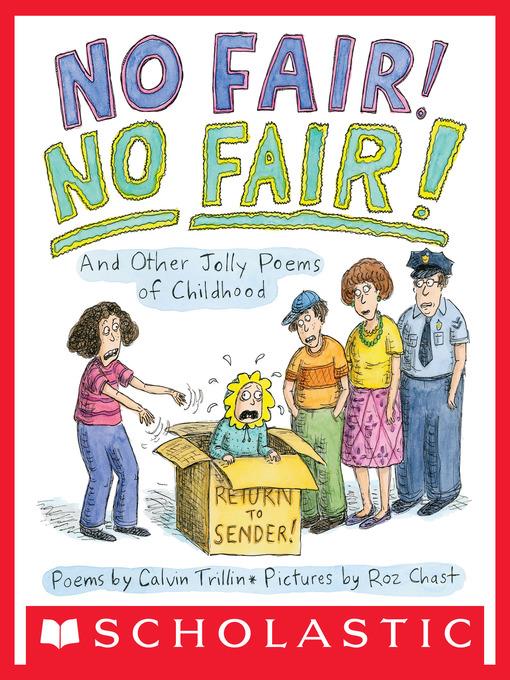
No Fair! No Fair!
And Other Jolly Poems of Childhood
فرمت کتاب
ebook
تاریخ انتشار
2016
Lexile Score
620
Reading Level
2-3
نویسنده
Roz Chastناشر
Scholastic Inc.شابک
9780545825795
کتاب های مرتبط
- اطلاعات
- نقد و بررسی
- دیدگاه کاربران
نقد و بررسی

June 13, 2016
Rein in your expectations: this is a book of wonderful illustrations and lackluster rhymes. Many start with clever ideas about coping with an unfair world: “How Many Stuffed Animals?” introduces a kid who solves her fear of the dark by sleeping under a mound of plush toys. But author and New Yorker staff writer Trillin’s verse never crackles with the possibilities of language’s playfulness, and the storytelling, particularly in the longer poems that dominate the collection, is equally pedestrian: “The animal pals that are piled in my bed/ Keep nighttime from being much scarier./ That’s why I need more. I’ve got plenty of room./ For me, it’s the more pals the merrier.” It’s only in one set of four short verses, grouped under the title “Evening Complaints” (there are also lesser “Morning Complaints” and “School Complaints”), that an authentically juvenile voice emerges. The anxiety and sense of being put-upon that threads through these verses are mother’s milk for Chast (Around the Clock), though, and her drawings are consistently funny. Ages 3–5. Author’s agent: Eric Simonoff, William Morris Endeavor. Illustrator’s agent: Jin Auh, Wylie Agency.

June 15, 2016
The Thurber Prize winner's first collection of poetry for children has a familiar feel, except for that blue hyena. In poems generally inspired by real-life experiences, Trillin turns his gaze upon the ebb and flow of childhood. The kids here are sure to strike a familiar chord with anyone who knows a stuffed-animal hoarder or has a sister incapable of keeping to her side of the back seat. For readers accustomed to Shel Silverstein, Jack Prelutsky, and the like, Trillin breaks little new ground with this collection, presenting such usual suspects as kids who want a dog ("To Get a Pet"), unwanted younger siblings ("Baby Brother Billy"), and bossy older siblings ("Who Plays What"). There are some notable exceptions, however, as in "Who's the Awfulest Kid in Your Class?" in which a nephew with an inquisitive uncle feels compelled to invent a bully. Trillin's wordplay can be enjoyable ("She's over the line, / She's over the line. / She occupies space / That's rightfully mine") but more often than not merely feels diligent. Chast's beleaguered, oft-frenzied, only occasionally multiracial denizens do much to elevate Trillin's familiar subjects. Her blue hyena is an exercise in child-friendly psychosis, while her pictorial demonstration of shoe-tying mishaps is laugh-out-loud funny. More of the same--but a nice more. (Picture book/poetry. 7-10)
COPYRIGHT(2016) Kirkus Reviews, ALL RIGHTS RESERVED.

September 1, 2016
Gr 2-5-Longtime contributors to The New Yorker combine their talents in this collection of rhyming poetry with ink and watercolor cartoons. Zany and humorous, the illustrations tend only to reinforce plot points, with little to no attempt to extend themes. Rare exceptions occur, such as in "The Backseat," where a brother grimaces and cringes away from his sister as she crowds him in a car's backseat. Anyone who sat in a similar position with their sibling can relate to Trillin's chant "she'll slowly, slowly, slowly start to slide/Till parts of her are clearly on my side" and will audibly groan at the wide grin spreading across his sister's face. Unfortunately, most of the other poems and artwork are not as harmonious. In "To Get a Pet," for example, a series of cartoon panels simply chart events in the poem and leave little room for imagination. Awkward repetitive phrasing, likely implemented to aid the rhyming scheme, interferes with the flow of several poems, as in "Eating Habits": "Matt loved the food most kids considered weird./Weird food from this boy's plate just disappeared." While adults may take such reverse phrasing in stride, emerging readers will struggle. Also, this title seems to be generally geared more toward boys, with nine out of 14 poems expressing male point of view through words or art. VERDICT A successful humorist whose work is better suited for adults. Consider for libraries with larger poetry collections.-Rachel Zuffa, Racine Public Library, WI
Copyright 2016 School Library Journal, LLC Used with permission.

July 1, 2016
Preschool-G These New Yorker stalwarts should make a winning children's-book combination, and in many ways, they do. Trillin, who often writes in humorous verse, has a way with a rhyme, and Chast, an award-winning cartoonist, has an eye for the grimace, the gloat, and, in some cases, the gluttony of childhood. But the book's subtitle gives the game away: it's a wink and a nod to the audience of adult lenders and purchasers. The subjects are well-chosen if oft-trod territory: yucky food, stuffed animals, siblings sharing a backseat. The longer poems don't always deserve the length Trillin delivers, and sometimes the premise is off. For instance, Who's the Awfulest Kid in Your Class? concerns a boy whose uncle continually asks that question. Ultimately, the child makes up a bully since, as he says, no kid in my class is that bad. Made-up bullies when there are such disgusting real ones? Chast's signature artwork captures the sweetness, fun, and occasional horror of childhood, and there are certainly a number of laughs. Jolly enough!(Reprinted with permission of Booklist, copyright 2016, American Library Association.)

























دیدگاه کاربران